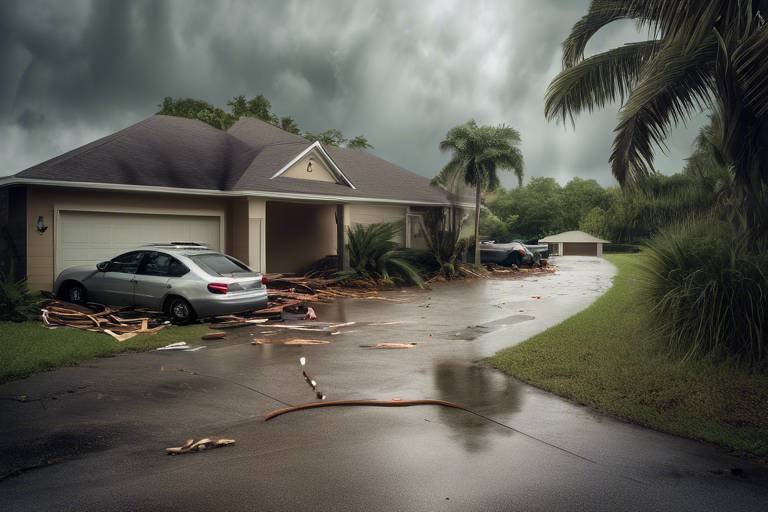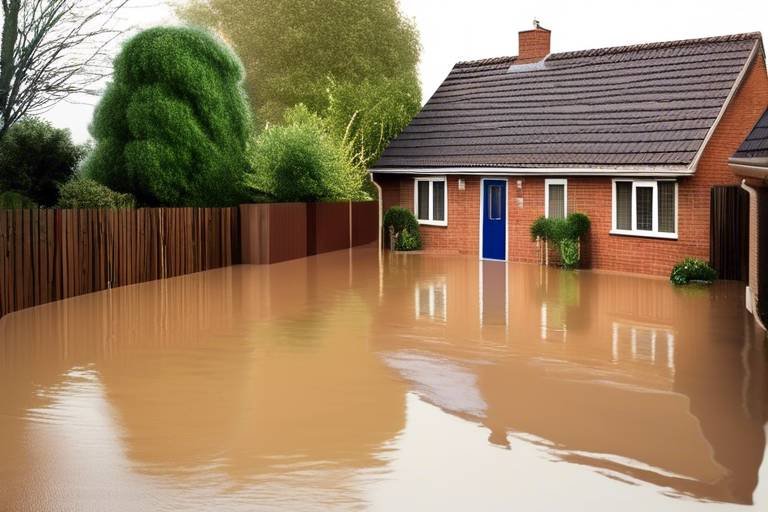Saving for Emergencies – A Key Aspect of Preparedness
In today's unpredictable world, the concept of emergency savings is more crucial than ever. Imagine waking up one day to find out that your car has broken down, or worse, you've lost your job. These situations can feel like a punch to the gut, leaving you gasping for air. But what if you had a financial safety net to fall back on? This is where emergency savings come into play. They are not just a luxury; they are a necessity that can provide you with peace of mind and financial stability when life throws you a curveball.
Emergency savings act as a buffer against life's unexpected events. Think of them as your financial superhero, swooping in to save the day when you need it most. Without this safety net, you might find yourself relying on credit cards or loans, which can lead to a vicious cycle of debt. By prioritizing your emergency savings, you can enhance your overall financial resilience and ensure that you’re prepared for whatever life has in store.
To truly grasp the importance of having an emergency fund, consider this: many financial experts recommend saving enough to cover three to six months of living expenses. This might sound daunting, but breaking it down into manageable steps can make it feel less overwhelming. For instance, you could start by saving a small percentage of your income each month. Over time, those contributions will add up, and before you know it, you'll have a robust emergency fund that can help you weather any storm.
In addition to providing a safety net, having emergency savings can also reduce stress. Knowing that you have funds set aside for unforeseen circumstances allows you to focus on other aspects of your life without the constant worry of financial instability. It's like having a warm blanket on a cold night; it brings comfort and reassurance. So, as we delve deeper into this article, keep in mind the vital role that emergency savings play in your financial strategy. They are your first line of defense against the unexpected, and building this fund is a proactive step towards achieving financial security.
Emergency savings provide a financial safety net during unforeseen circumstances. Understanding their significance can motivate individuals to prioritize saving and enhance their overall financial stability.
Determining the right amount to save for emergencies can vary based on personal circumstances. This section discusses guidelines to help individuals assess their needs and set realistic savings goals.
Evaluating monthly expenses is crucial in calculating how much to save. This subheading provides methods to track spending and identify areas where savings can be increased.
Understanding the difference between fixed and variable expenses helps prioritize savings. This section explains how to categorize expenses for better financial planning.
Using multiples of monthly expenses as a benchmark for savings can provide clarity. This section discusses common recommendations for emergency fund sizes based on individual circumstances.
A structured savings plan is essential for building an emergency fund. This subheading outlines steps to create a personalized plan that aligns with financial goals.
Choosing the right account for your emergency savings can impact accessibility and growth. This section reviews various options available for storing emergency funds effectively.
High-yield savings accounts offer better interest rates than traditional accounts. This subheading discusses the benefits of using these accounts for emergency savings.
Money market accounts provide both liquidity and interest. This section explores how they can serve as a viable option for emergency savings while maintaining accessibility.
Once established, it's vital to maintain your emergency fund. This section discusses tips for keeping the fund intact and strategies for replenishing it after use.
Consistently contributing to your emergency fund helps it grow over time. This subheading emphasizes the importance of regular deposits to ensure financial preparedness.
Periodic reassessment of your emergency fund ensures it meets current needs. This section highlights the importance of adjusting savings goals based on life changes and financial situations.
- What is an emergency fund? An emergency fund is a savings account specifically set aside for unexpected expenses, such as medical emergencies, car repairs, or job loss.
- How much should I have in my emergency fund? Financial experts typically recommend saving three to six months' worth of living expenses, but this can vary based on individual circumstances.
- Where should I keep my emergency fund? High-yield savings accounts and money market accounts are popular options as they offer better interest rates and easy access to funds.
- How can I build my emergency fund quickly? Start by setting a monthly savings goal and automate your contributions. Look for areas in your budget where you can cut back to increase your savings.

The Importance of Emergency Savings
Emergency savings are like a safety net that catches you when life throws unexpected curveballs. Whether it’s a sudden job loss, an unexpected medical bill, or urgent home repairs, having a financial cushion can make all the difference. Imagine standing on a tightrope, high above the ground, with nothing but a flimsy rope to hold onto. That’s what life feels like without an emergency fund. By prioritizing emergency savings, you not only enhance your financial stability but also gain peace of mind knowing that you’re prepared for whatever comes your way.
The significance of emergency savings cannot be overstated. It’s not just about having money set aside; it’s about creating a sense of security and resilience. When you have a dedicated fund for emergencies, you’re less likely to rely on credit cards or loans, which can lead to debt spirals and financial stress. Instead, you can tackle unexpected expenses head-on, allowing you to maintain your quality of life and avoid the anxiety that comes with financial uncertainty.
Think about it: how would you feel if you suddenly faced a hefty car repair bill? Would you panic, or would you breathe a sigh of relief knowing you have the funds to cover it? This is why emergency savings should be a top priority for everyone. Here are some compelling reasons to start building your emergency fund today:
- Financial Security: Having a buffer allows you to navigate life's hurdles without derailing your finances.
- Reduced Stress: Knowing you have money set aside can alleviate anxiety during tough times.
- Better Financial Decisions: With an emergency fund, you can make more informed choices without the pressure of financial strain.
In a world where uncertainty is the only certainty, establishing an emergency fund is a proactive step towards financial resilience. It empowers you to take control of your financial future and reduces the likelihood of falling into debt. So, start today! Set a goal, create a plan, and watch your emergency savings grow. Remember, it’s not about how much you save initially, but the habit of saving consistently that will lead you to financial freedom.

How Much Should You Save?
Determining the right amount to save for emergencies can feel like trying to hit a moving target. Everyone's situation is different, and what works for one person might not suit another. However, there are some general guidelines that can help you assess your needs and set realistic savings goals. Think of your emergency fund as a financial cushion, one that gives you peace of mind when life throws unexpected curveballs your way.
First, consider your monthly expenses. A good starting point is to calculate your essential living costs, which include rent or mortgage payments, utilities, groceries, transportation, and any other necessary bills. Once you have a clear picture of these expenses, you can start to think about how much you should ideally have saved up. Many financial experts recommend aiming for three to six months' worth of living expenses. This might sound daunting, but breaking it down into smaller, achievable goals can make it feel more manageable.
To give you a clearer idea, let’s break it down:
| Monthly Expenses | 3 Months of Expenses | 6 Months of Expenses |
|---|---|---|
| $2,000 | $6,000 | $12,000 |
| $3,000 | $9,000 | $18,000 |
| $4,000 | $12,000 | $24,000 |
Now, this is where things get personal. You might find that your circumstances require a different approach. For instance, if you have a stable job and minimal expenses, you might feel comfortable with just three months of savings. On the other hand, if your income is variable or you're in a high-cost living area, you may want to aim for that six-month mark or even more. It’s all about finding what feels right for you.
Another factor to consider is your job security. If you work in a field that is prone to layoffs or economic downturns, having a more substantial emergency fund can be a lifesaver. It’s like having a safety net while you navigate through uncertain waters. On the flip side, if you have a steady income and a strong job market, you might not need as much saved up.
Lastly, don’t forget to reassess your emergency fund periodically. Life changes, whether it’s a new job, a move, or a family addition, can impact your financial needs. It’s essential to adjust your savings goals as your situation evolves. Remember, the goal is to create a fund that not only protects you but also gives you the confidence to handle whatever life throws your way.

Assessing Your Monthly Expenses
Evaluating your monthly expenses is a crucial step in determining how much you should save for emergencies. Think of it as taking inventory of your financial life; just like you wouldn’t go camping without checking your gear, you shouldn’t attempt to save without knowing where your money goes each month. By understanding your spending habits, you can identify areas where you might cut back and allocate those funds toward your emergency savings. It’s not just about knowing the numbers; it’s about gaining control over your financial destiny.
To start, you can track your expenses over a month or two. Use a simple spreadsheet or a budgeting app to categorize your spending. This way, you can see where your money is flowing. Here are some categories to consider:
- Fixed Expenses: These are your non-negotiables, like rent or mortgage, utilities, insurance, and loan payments.
- Variable Expenses: These include groceries, dining out, entertainment, and other discretionary spending.
- Savings and Investments: Don't forget to account for any contributions to retirement accounts or other savings.
Once you have a clear picture of your monthly expenses, the next step is to analyze them. Are there any subscriptions you no longer use? Are you spending more on takeout than you realize? By pinpointing these areas, you can make informed decisions about where to cut back. For example, if you find you’re spending $200 a month on dining out, consider reducing that to $100 and diverting the extra $100 into your emergency fund. It’s all about making conscious choices that align with your financial goals.
Additionally, consider creating a spending plan that outlines your essential expenses versus your non-essential ones. This can help you prioritize what truly matters to you and where you can save. You might be surprised by how much you can save simply by being more mindful of your spending habits. Remember, every little bit counts when it comes to building your emergency fund!
In conclusion, assessing your monthly expenses isn’t just about crunching numbers; it’s about gaining insight into your financial behavior. By regularly reviewing your spending, you can create a sustainable savings plan that not only prepares you for emergencies but also enhances your overall financial health.
Q: How often should I assess my monthly expenses?
A: It's a good practice to review your expenses at least once a month. This helps you stay aware of your spending habits and make necessary adjustments.
Q: What tools can I use to track my expenses?
A: You can use budgeting apps, spreadsheets, or even a simple pen and paper. The key is to find a method that works best for you.
Q: How can I ensure I stick to my budget?
A: Setting clear financial goals and regularly reviewing your budget can help you stay on track. Additionally, consider using the envelope system or automatic transfers to your savings account.

Fixed vs. Variable Expenses
Understanding the difference between fixed and variable expenses is crucial for effective financial planning. Fixed expenses are those that remain constant each month, such as rent or mortgage payments, insurance premiums, and certain utilities. These are the costs that you can rely on to be the same, making them predictable and easier to budget for. On the other hand, variable expenses fluctuate from month to month. These include groceries, entertainment, and other discretionary spending. The variability in these costs can make them a bit trickier to manage, but they also offer opportunities for savings.
When it comes to building your emergency fund, categorizing your expenses can help you identify areas where you might cut back. For example, if you find that your variable expenses are higher than expected, you can adjust your spending habits. Here’s a simple breakdown:
| Type of Expense | Examples | Characteristics |
|---|---|---|
| Fixed Expenses | Rent, mortgage, insurance | Consistent, predictable |
| Variable Expenses | Groceries, dining out, entertainment | Fluctuating, discretionary |
By understanding these categories, you can prioritize your savings effectively. For instance, if you know your fixed expenses take up a significant portion of your income, you can focus on reducing your variable expenses to free up more funds for your emergency savings. Additionally, keeping an eye on your spending habits can help you avoid unnecessary expenses, allowing you to build that safety net faster.
So, the next time you sit down to review your budget, take a moment to dissect your expenses. Are there areas where you can cut back on variable costs? Are your fixed expenses as low as they can be? By answering these questions, you’ll be well on your way to establishing a robust emergency fund that can weather any storm.
- What is an emergency fund? An emergency fund is a savings account specifically set aside for unexpected expenses, such as medical emergencies or car repairs.
- How much should I have in my emergency fund? A common guideline is to save three to six months’ worth of living expenses, but this can vary based on individual circumstances.
- What should I do if I have to use my emergency fund? If you need to dip into your emergency savings, make a plan to replenish it as soon as possible to ensure you remain financially secure.

Emergency Fund Multiples
When it comes to building your emergency fund, one effective strategy is to use . This concept revolves around saving a specific number of months' worth of expenses, which can serve as a solid benchmark for your financial preparedness. Think of it as a safety net that expands or contracts based on your personal circumstances. But how do you determine the right multiple for you?
Generally, financial experts recommend saving anywhere from three to six months' worth of living expenses. This range is a good starting point, but it’s essential to consider your unique situation. For instance, if you have a stable job, no dependents, and minimal debt, you might lean towards the lower end of that spectrum. Conversely, if you’re self-employed, have a family to support, or face unpredictable income, aiming for six months or more could provide greater peace of mind.
To help clarify this concept, let's break down the expenses you should consider when calculating your emergency fund multiple:
| Expense Type | Examples |
|---|---|
| Fixed Expenses | Rent/Mortgage, Utilities, Insurance |
| Variable Expenses | Groceries, Transportation, Entertainment |
| Debt Payments | Credit Card Bills, Student Loans, Car Payments |
| Miscellaneous Expenses | Medical Bills, Childcare, Unexpected Repairs |
Once you’ve calculated your total monthly expenses, simply multiply that figure by your chosen multiple. For example, if your monthly expenses total $3,000 and you decide on a six-month multiple, your target emergency fund would be:
$3,000 x 6 $18,000
This means you should aim to save $18,000 in your emergency fund. It’s important to remember that this amount is not set in stone. Life is dynamic, and your financial needs may change. Regularly reassessing your expenses and adjusting your emergency fund multiple accordingly can help ensure that you’re always prepared for the unexpected.
In summary, using emergency fund multiples is a practical approach to determining how much to save. By understanding your expenses and choosing a multiple that reflects your personal situation, you can create a robust financial buffer that offers peace of mind in times of crisis.

Creating a Savings Plan
Building an emergency fund isn't just about stashing away cash; it's about creating a strategic savings plan that aligns with your financial goals and lifestyle. Think of it as creating a blueprint for your financial fortress, where every brick represents a dollar saved. So, how do you go about crafting this plan? Let’s break it down into manageable steps that can help you lay the foundation for your financial security.
First off, start by setting a realistic savings goal. This goal should be based on your monthly expenses and other financial commitments. For instance, if your monthly expenses total $3,000, a common recommendation is to aim for three to six months' worth of expenses saved. This means your emergency fund should ideally sit between $9,000 and $18,000. It might sound daunting at first, but remember, every little bit counts!
Next, to make saving less overwhelming, consider breaking your goal down into smaller, achievable milestones. Instead of focusing on the total amount, concentrate on saving a specific amount each month. For example, if you aim to save $12,000 in two years, that breaks down to $500 a month. By focusing on this smaller target, you can track your progress without feeling like you're climbing a mountain.
Now, let’s talk about where to stash that cash. Choosing the right account is crucial. You want an account that offers both accessibility and growth. A high-yield savings account or a money market account can be excellent choices. These accounts typically offer better interest rates than regular savings accounts, allowing your emergency fund to grow while still being easily accessible when you need it.
Once you have your goal and account set up, it’s time to automate your savings. This means setting up automatic transfers from your checking account to your emergency fund. By doing this, you treat your savings like a recurring bill, which can help you stay disciplined. You won’t even miss the money because it’s out of sight and out of mind!
Lastly, don't forget to review and adjust your savings plan regularly. Life changes, and so do our financial needs. Maybe you get a new job, have a child, or face unexpected expenses. Whatever the case, reassessing your plan ensures that it remains relevant and effective. Regular check-ins can also motivate you to stay on track and make necessary adjustments to your savings contributions.
In summary, creating a savings plan is all about setting clear goals, breaking them down into manageable steps, choosing the right accounts, automating your savings, and regularly reviewing your financial situation. By following these steps, you’ll not only build a robust emergency fund but also gain peace of mind knowing you’re prepared for whatever life throws your way.
- How much should I have in my emergency fund? It’s generally recommended to save three to six months' worth of living expenses.
- Where is the best place to keep my emergency fund? High-yield savings accounts and money market accounts are great options due to their accessibility and better interest rates.
- How can I automate my savings? Set up automatic transfers from your checking account to your savings account each month.
- What if I use my emergency fund? Make it a priority to replenish your fund as soon as possible to ensure you're prepared for future emergencies.

Where to Keep Your Emergency Fund
Choosing the right place to stash your emergency fund is like picking the perfect home for your prized possessions. You want it to be safe, accessible, and ideally, it should help your money grow. The landscape of financial institutions offers a variety of options, each with its own set of benefits and drawbacks. Let’s dive into some of the most popular choices for keeping your emergency savings secure while ensuring they’re ready to use when life throws a curveball.
One of the most common places to keep your emergency fund is in a high-yield savings account. These accounts typically offer interest rates significantly higher than traditional savings accounts, allowing your money to grow while remaining liquid. Imagine being able to earn interest without sacrificing access to your funds—sounds like a win-win, right? However, it’s essential to shop around and compare rates, as they can vary widely between banks. Look for accounts with no monthly fees and minimal withdrawal limits to maximize your savings potential.
Another viable option is a money market account. These accounts often combine the features of checking and savings accounts, offering higher interest rates along with check-writing privileges. This means you can access your funds easily without sacrificing the ability to earn a better return on your savings. However, keep in mind that money market accounts may require a higher minimum balance than standard savings accounts, which could be a barrier for some. Still, they provide a nice balance of accessibility and growth potential.
For those who prefer a more traditional approach, regular savings accounts might be the way to go. While they typically offer lower interest rates, they are familiar and straightforward. The key is to ensure that your chosen account has no hidden fees that could eat into your savings. Remember, the goal is to have quick access to your funds when you need them without unnecessary costs.
In addition to these options, it’s worth considering Certificates of Deposit (CDs) for a portion of your emergency fund. While CDs lock your money away for a fixed term, they often provide better interest rates than standard savings accounts. This can be a great strategy if you have a portion of your emergency fund that you don’t anticipate needing immediately. Just be cautious about the penalties for early withdrawal, as you don’t want to find yourself in a tight spot if an emergency arises.
Ultimately, the best place for your emergency fund depends on your personal financial situation and comfort level. Here’s a quick comparison of the options discussed:
| Account Type | Interest Rate | Accessibility | Minimum Balance |
|---|---|---|---|
| High-Yield Savings Account | High | Easy | Varies |
| Money Market Account | Moderate to High | Easy | Usually higher |
| Regular Savings Account | Low to Moderate | Very Easy | Low |
| Certificates of Deposit (CDs) | Higher | Limited | Varies |
In conclusion, where you keep your emergency fund is crucial for your financial resilience. Take the time to evaluate your options, considering factors such as interest rates, accessibility, and any fees involved. By carefully selecting the right account, you can ensure that your emergency fund remains a robust safety net, ready to catch you when life gets unpredictable.
1. How much should I have in my emergency fund?
A common guideline is to save three to six months' worth of living expenses. However, your specific needs may vary based on your personal situation.
2. Can I use my emergency fund for planned expenses?
An emergency fund is designed for unexpected expenses. It’s best to keep it separate from your regular savings for planned expenses.
3. How often should I reassess my emergency fund?
It’s a good idea to review your emergency fund at least once a year or whenever you experience significant life changes, such as a new job or a move.

High-Yield Savings Accounts
When it comes to saving for emergencies, one of the best places to park your hard-earned cash is in a high-yield savings account. Unlike traditional savings accounts that offer minimal interest rates, high-yield accounts can offer significantly higher returns, which means your money can grow faster. Imagine your savings working as hard for you as you do for them! With the right high-yield account, you can earn interest rates that might be several times higher than the national average, giving you a better chance of reaching your financial goals.
So, what makes high-yield savings accounts stand out? For starters, they typically have lower fees and fewer restrictions compared to other investment options. This means you can access your funds without worrying about hefty penalties or monthly maintenance fees. Additionally, many high-yield accounts are offered by online banks, which often have lower overhead costs and can pass those savings onto you in the form of better interest rates. It's like finding a hidden gem in the world of finance!
Here’s a quick comparison to illustrate the potential benefits of high-yield savings accounts:
| Account Type | Average Interest Rate | Accessibility | Fees |
|---|---|---|---|
| Traditional Savings Account | 0.01% - 0.05% | High | Monthly Fees |
| High-Yield Savings Account | 0.50% - 2.00%+ | Moderate | Low or No Fees |
As you can see, the difference in interest rates can be substantial. This is especially important when you're trying to build an emergency fund that can cover three to six months' worth of expenses. Every little bit counts, and the more interest you earn, the quicker you'll reach your savings target.
Another aspect to consider is liquidity. High-yield savings accounts allow you to access your funds quickly in case of an emergency, without the hassle of waiting for a transfer or dealing with withdrawal limits that some investment accounts impose. This accessibility is crucial when unexpected expenses arise, such as medical bills or urgent home repairs.
However, it's essential to shop around before committing to a high-yield savings account. Not all accounts are created equal, and rates can fluctuate based on market conditions. Look for accounts with the best rates, minimal fees, and good customer service. After all, you want your savings experience to be as smooth as possible, right?
In conclusion, high-yield savings accounts are not just a smart choice for your emergency fund; they are a powerful tool that can help you achieve financial resilience. By choosing the right account, you can ensure that your savings not only remain intact but also grow over time, providing you with peace of mind in uncertain situations.
- What is a high-yield savings account? A high-yield savings account is a type of savings account that offers significantly higher interest rates compared to traditional savings accounts.
- How do I find the best high-yield savings account? Compare interest rates, fees, and account features from various banks, especially online banks, to find the best option for your needs.
- Are there any risks associated with high-yield savings accounts? Generally, high-yield savings accounts are low-risk as they are usually FDIC insured, but it's important to read the terms and conditions carefully.
- Can I access my money easily in a high-yield savings account? Yes, most high-yield savings accounts allow for easy access to your funds, making them an excellent option for emergency savings.

Money Market Accounts
When it comes to saving for emergencies, Money Market Accounts (MMAs) can be a fantastic option. These accounts blend the benefits of both savings and checking accounts, allowing you to earn interest while still having easy access to your funds. Imagine having a safety net that not only keeps your money secure but also helps it grow! That's precisely what MMAs offer. They typically provide higher interest rates compared to traditional savings accounts, making them an attractive choice for your emergency fund.
One of the standout features of Money Market Accounts is their liquidity. This means you can withdraw your cash whenever you need it, making them ideal for unexpected expenses. However, it's essential to note that most MMAs come with certain restrictions, such as a limit on the number of withdrawals you can make each month. This limitation encourages you to think twice before dipping into your emergency fund, which is a good practice.
Additionally, MMAs often require a higher minimum balance than standard savings accounts. While this might seem like a hurdle, it can actually help you develop better savings habits. By committing to maintaining a higher balance, you're less likely to spend frivolously. Moreover, many financial institutions provide competitive interest rates for MMAs, which can significantly enhance your savings over time. Here’s a quick comparison of some common features:
| Feature | Money Market Account | Traditional Savings Account |
|---|---|---|
| Interest Rates | Higher | Lower |
| Withdrawal Limits | Limited | Often Unlimited |
| Minimum Balance Requirement | Higher | Lower |
| Check Writing | Allowed | Not Allowed |
When selecting a Money Market Account, it's crucial to compare different banks and credit unions. Look for accounts that offer the best interest rates and the most favorable terms. Some institutions may even provide additional perks, like ATM access or online banking features, which can make managing your emergency fund even more convenient. Remember, the goal is to find a balance between accessibility and growth, ensuring your emergency savings work as hard as possible for you.
In conclusion, Money Market Accounts can be a smart choice for your emergency fund. They offer a unique combination of liquidity and competitive interest rates, making them a valuable asset in your financial toolkit. By choosing the right account and maintaining a healthy balance, you can ensure that your emergency savings are both secure and growing. Now that we've explored the ins and outs of MMAs, let's dive into some Frequently Asked Questions to clarify any lingering doubts!
- What is a Money Market Account? A Money Market Account is a type of savings account that typically offers higher interest rates and allows limited check-writing and debit card transactions.
- Are there fees associated with Money Market Accounts? Some MMAs may charge monthly maintenance fees or require a minimum balance to avoid fees. It's important to read the fine print before opening an account.
- How do I choose the right Money Market Account? Compare interest rates, fees, and features from different banks or credit unions to find an account that best fits your financial needs.

Maintaining Your Emergency Fund
Once you've established your emergency fund, the journey doesn't stop there. In fact, maintaining your emergency fund is just as crucial as building it in the first place. Think of your emergency fund as a garden; if you don't tend to it, it can easily become overgrown with weeds or, worse, dry up completely. So, how can you ensure that your financial safety net remains robust and ready for any unexpected events? Let's dive into some effective strategies.
First and foremost, regular contributions are key. Just like watering your plants, consistently adding to your emergency fund helps it flourish over time. You might consider setting up automatic transfers from your checking account to your emergency savings account. This way, you're not only saving without even thinking about it, but you're also creating a habit that can lead to substantial growth over time. Even if it's a small amount, like $20 or $50 a month, every little bit counts. Over the course of a year, those contributions can add up significantly!
Another important aspect of maintaining your emergency fund is reassessing your fund periodically. Life is full of changes—new jobs, relocations, family additions, or even unexpected expenses. As your circumstances evolve, so too should your savings goals. It’s a good idea to sit down every six months or so and evaluate your current financial situation. Ask yourself questions like:
- Have my monthly expenses increased or decreased?
- Do I have any new financial responsibilities that require a larger emergency fund?
- Am I still comfortable with my current savings target, or should I adjust it?
This kind of reflection not only keeps your emergency fund relevant but also helps you stay aligned with your financial goals. Remember, the amount you need saved can vary dramatically based on life events, so being proactive about these changes ensures you’re always prepared.
Lastly, it's essential to have a plan in place for replenishing your emergency fund if you ever need to dip into it. Life can throw curveballs, and sometimes you might find yourself using your savings for an unexpected car repair or medical bill. When this happens, it’s crucial to have a strategy for rebuilding that fund. Consider making a commitment to add a larger amount to your fund in the following months or temporarily cutting back on non-essential expenses until you reach your desired savings level again. Just like a sprinter who takes a moment to catch their breath before the next race, replenishing your fund can help you feel secure and ready for whatever comes next.
In conclusion, maintaining your emergency fund is all about consistency, reassessment, and a solid plan for replenishment. By treating your emergency fund with care and attention, you'll ensure that it remains a reliable safety net, ready to support you through life's unexpected twists and turns.
1. How much should I regularly contribute to my emergency fund?
It's best to start with a manageable amount that fits your budget. Even small, consistent contributions can lead to significant growth over time. Aim for at least $20 to $50 a month, and adjust as your financial situation allows.
2. How often should I reassess my emergency fund?
A good rule of thumb is to review your emergency fund every six months. This allows you to adjust your savings goals based on any life changes or shifts in your financial situation.
3. What should I do if I need to use my emergency fund?
If you need to dip into your emergency fund, make a plan to replenish it as soon as possible. Consider increasing your contributions temporarily or cutting back on discretionary spending until you can rebuild your savings.

Regular Contributions
When it comes to building and maintaining your emergency fund, are your best friend. Think of your emergency fund as a garden; if you want it to flourish, you need to water it consistently. Just like plants need regular care to grow, your savings need consistent deposits to thrive. But how do you make this a habit? It's simpler than you might think!
First, consider setting up an automatic transfer from your checking account to your emergency fund. This way, you can "set it and forget it." By automating your savings, you ensure that a portion of your income goes directly into your emergency fund before you even have the chance to spend it. Imagine waking up each month knowing that your savings are growing without you having to lift a finger! This method not only makes saving easier but also helps you avoid the temptation to spend that money on non-essentials.
But how much should you contribute? That depends on your personal financial situation. A good rule of thumb is to aim for a small percentage of your income—say, 10% to 20%. If that seems daunting, start small! Even a modest amount can add up over time. For example, if you save just $50 a month, in a year, you'll have $600 saved up. Over five years, that amounts to $3,000. Imagine the peace of mind that comes with knowing you have that cushion to fall back on in case of an emergency!
To make it even more engaging, consider creating a savings challenge for yourself. You could start with a small amount and gradually increase your contributions each month. For instance, you might save $25 in the first month, $50 in the second, and so forth. This strategy not only keeps your savings interesting but also helps you build the habit of contributing regularly.
Here's a quick overview of how regular contributions can impact your emergency fund over time:
| Months | Monthly Contribution | Total Savings |
|---|---|---|
| 1 | $50 | $50 |
| 6 | $50 | $300 |
| 12 | $50 | $600 |
| 24 | $50 | $1,200 |
| 60 | $50 | $3,000 |
In conclusion, regular contributions to your emergency fund are crucial for financial stability. They not only help you build a safety net but also instill a sense of discipline in your financial habits. Remember, the journey of a thousand miles begins with a single step. So, take that first step today, and watch your emergency fund grow!
- How much should I save each month? Aim for 10% to 20% of your income, but start with what you can comfortably afford.
- What if I need to use my emergency fund? It's okay! Just make sure to replenish it with regular contributions afterward.
- Can I keep my emergency fund in a regular savings account? Yes, but consider high-yield savings accounts for better interest rates.

Reassessing Your Fund Periodically
Reassessing your emergency fund periodically is like checking the air pressure in your tires before a long road trip. You wouldn't want to hit the highway with under-inflated tires, right? Similarly, your emergency fund needs to reflect your current financial situation and life circumstances. As life evolves, so do your financial needs. Whether it's a new job, a growing family, or even a change in your health, these factors can significantly impact how much you should have saved for emergencies.
It's essential to set aside time, perhaps every six months or annually, to review your financial landscape. Start by evaluating your current monthly expenses. Have they increased due to inflation or lifestyle changes? Are there new fixed expenses, like a mortgage or tuition, that require a reevaluation of your savings goals? Understanding these shifts will help you determine if your emergency fund is still adequate.
Moreover, consider the 3 to 6 months rule: many financial experts recommend having three to six months' worth of living expenses saved. However, this isn't a one-size-fits-all rule. For instance, if you’re self-employed or work in a volatile industry, you might want to aim for a larger fund. On the other hand, if you have a stable job and additional income sources, a smaller fund might suffice. Here’s a quick table to illustrate how different life situations might affect your savings target:
| Life Situation | Recommended Emergency Fund |
|---|---|
| Stable Employment | 3 months of expenses |
| Self-Employed | 6 months or more of expenses |
| New Parents | 6 months of expenses |
| Retirees | 6 months or more of expenses |
Additionally, life events such as marriage, divorce, or the birth of a child can drastically change your financial picture. If you’ve recently moved to a new area with a higher cost of living, for example, it’s crucial to adjust your savings goals accordingly. Remember, the aim is to ensure that your emergency fund can adequately cover your needs in times of crisis.
Finally, don't forget to consider your income stability. If you've recently received a promotion or a raise, it might be a good time to increase your contributions to your emergency fund. Conversely, if you’re facing a pay cut or job uncertainty, you may need to reassess how much you're saving and possibly adjust your budget to ensure you can maintain that safety net.
In conclusion, regularly reassessing your emergency fund is a vital part of maintaining financial health. Just like a garden requires regular watering and weeding, your finances need attention and adjustment to thrive. Stay proactive, and you’ll be well-prepared for whatever life throws your way!
- How often should I reassess my emergency fund? It's recommended to review your fund every six months or at least once a year.
- What if my expenses change drastically? If you experience a significant change in your expenses, it's wise to reassess your emergency fund immediately.
- Can I use my emergency fund for non-emergencies? It's best to reserve your emergency fund for true emergencies to maintain its purpose and integrity.
Frequently Asked Questions
- What is an emergency fund and why is it important?
An emergency fund is a savings account specifically set aside for unexpected expenses, like medical emergencies or car repairs. It's important because it acts as a financial safety net, helping you avoid debt and maintain your financial stability during tough times.
- How much should I aim to save in my emergency fund?
The amount you should save can vary based on your personal circumstances, but a common guideline is to save three to six months' worth of living expenses. This can give you enough cushion to handle most emergencies without financial strain.
- What are fixed and variable expenses?
Fixed expenses are regular, unchanging costs like rent or mortgage payments, while variable expenses can fluctuate, such as groceries or entertainment. Understanding these differences helps you prioritize your savings and budget more effectively.
- Where is the best place to keep my emergency fund?
High-yield savings accounts and money market accounts are often recommended for emergency funds. They offer better interest rates than traditional savings accounts while maintaining easy access to your money when you need it.
- How can I maintain and grow my emergency fund?
Regular contributions are key! Set up automatic transfers to your emergency fund each month. Additionally, periodically reassess your fund to ensure it meets your current needs, especially after major life changes like a new job or moving.
- What should I do if I have to use my emergency fund?
If you dip into your emergency fund, it's crucial to replenish it as soon as possible. Consider adjusting your budget to increase contributions until you've restored the fund to its original level.



















